Understanding and mastering the art of Conversion Funnel Optimization (CFO) stands as the linchpin between visitor engagement and tangible results. Imagine your business as a leaky bucket; no matter how much traffic you generate, without a well-optimized conversion funnel, a significant portion of your potential customers might slip away, never to return.
Conversion Funnel Optimization isn’t just a buzzword; it’s the systematic process that guides your audience from initial awareness to becoming loyal customers. As we navigate this digital era, businesses need more than just a website; they need a finely tuned conversion funnel, adept at capturing attention, nurturing interest, and fostering customer loyalty.
In this comprehensive guide, we delve deep into the intricacies of Conversion Funnel Optimization. We’ll explore the stages of the conversion funnel, unravel the mysteries of user behavior, and dissect the strategies that can turn casual visitors into devoted patrons. Join us as we embark on a journey through the digital maze, where data-driven decisions and targeted techniques pave the way for enhanced user experience, increased conversions, and sustainable business growth.
Buckle up as we unravel the secrets behind crafting conversion funnels that not only attract but also retain, ensuring that every visitor counts and every click holds the promise of a meaningful customer relationship. Welcome to the world of Conversion Funnel Optimization, where digital possibilities meet real-world results.
Let’s optimize your funnels and transform your online presence.
What is a Conversion Funnel?
A conversion funnel is a strategic framework used in marketing to illustrate the customer’s journey from initial awareness to taking a desired action, such as making a purchase or becoming a lead.
It represents the stages a customer goes through, typically including awareness, interest, desire, and action, and highlights the gradual reduction in the number of potential customers as they progress toward the ultimate conversion goal.
Saad Kamal offers an excellent basic graphic representation of a conversion funnel using one of the oldest marketing models: AIDA, or Awareness, Interest, Desire, and Action.
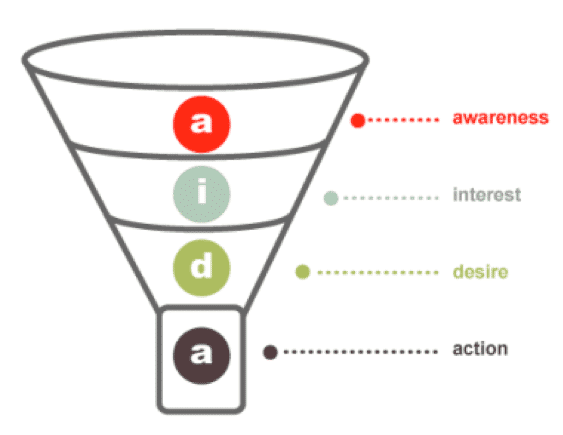
The graphic shows that your digital marketing reaches many people – creating Awareness of your product or company. It manages to capture the Interest of some of them. Even fewer develop a Desire for your offer. And only a small percentage of the original number of people you managed to reach at the Awareness level actually take Action, by either becoming a lead or a sale.
Other funnel graphics show your online customer’s journey from different points of view.
InteractiveMarketingInc.com shows us a funnel that outlines the percentages of customers who experience each stage of the journey, from arriving on your site to making a purchase.
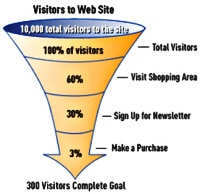
A conversion funnel from Clickz shows the online marketing tools that are in play at each step of the conversion path. It’s important to note the focus this funnel places on the steps following the call-to-action. For many, getting the customer to take the CTA is the end goal; the conversion. But, with ecommerce shopping cart abandonment rates well over 60%, the stages that follow your “Buy Now” or “Register Today” buttons are just as guilty of losing customers as those that come before.
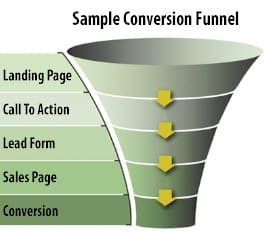
Our original lawnmower and science lab metaphors aren’t really a fair representation of a conversion funnel. And neither are most of the funnel graphics we use. When we funnel customers to our conversion goal, we aren’t literally using a funnel. We’re actually using the verb tense of “funnel”, which means, according to Dictionary.com, “to concentrate, channel or focus”.
But, even the verb imagery doesn’t give us a clear picture of what happens to our customers in the conversion funnel. Just like you wouldn’t use an actual funnel that delivered 97% of your lawnmower’s gasoline to the ground, you would never contribute to a charity that funneled only 3% of the funds you donated to the cause you support.
A graphic from UK’s Coast Digital gives us a better idea than most about what actually happens through an online conversion funnel. In addition to showing the stages of the funnel, it shows us where leaks happen and how big those leaks can be. In so doing, it tells us where we can begin to optimize.
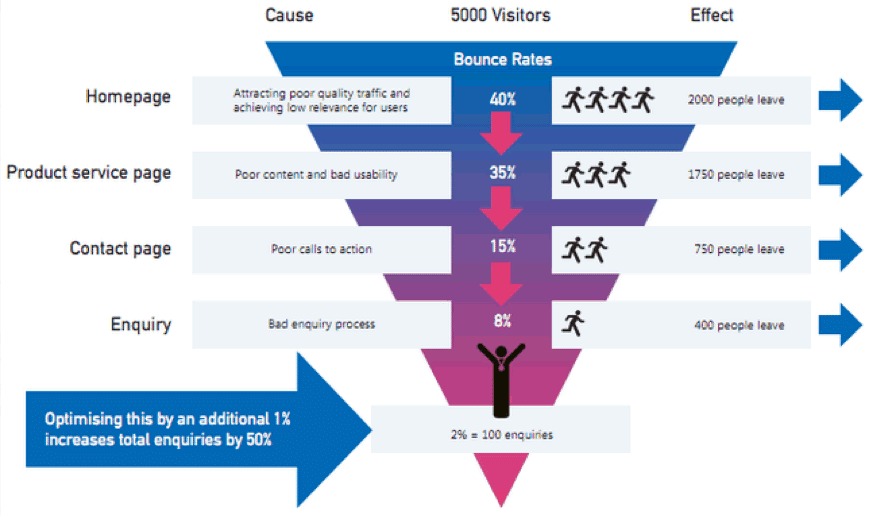
A previous post on the Invesp blog, “Optimizing Your Sales Funnel into a Marketing Funnel”, gives us what is perhaps the clearest image of your customers’ online conversion path. Not only does it show the holes in the funnel, but it highlights why they are there: the failure to engage your customer.
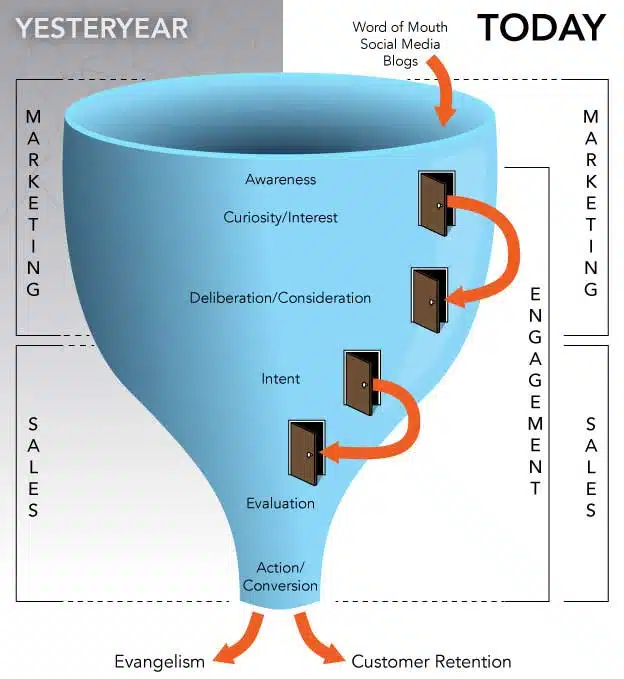
Customer Engagement and Optimizing Your Conversion Funnel
The Invesp blog post and graphic show us that, compared to traditional sales funnels, more emphasis must be placed on engaging your online customers because of the speed at which they could be sucked out of the funnel by any number of distractions, not the least of which is your competitor’s offer.
If customer engagement is key to keeping your prospects on the path to conversion, then you must ensure your conversion funnel gives your customer what she seeks every step of the way.
Importance Of Funnel Optimization
Funnel optimization is crucial for businesses as it directly impacts their bottom line. Here are the reasons why it’s important:
1. Maximizing Conversion Rates:
By optimizing conversion funnels, businesses can increase the percentage of prospects who convert into customers. This means more sales, leads, or desired actions, resulting in improved revenue and profitability.
2. Cost Efficiency:
Optimization helps businesses make the most out of their marketing investments. By focusing on the most effective stages of the funnel, businesses can allocate their resources efficiently, reducing wasteful spending and improving the return on investment (ROI) of their marketing campaigns.
3. Better Customer Experience:
A well-optimized funnel ensures a seamless and engaging customer journey. By identifying and addressing pain points or obstacles in the conversion process, businesses can enhance the overall customer experience. This leads to increased customer satisfaction, loyalty, and higher chances of repeat business or referrals.
4. Data-Driven Decision Making:
Optimization involves analyzing and interpreting data from the funnel’s performance. By collecting and analyzing relevant metrics, businesses gain valuable insights into customer behavior, preferences, and trends. This data-driven approach enables informed decision-making and the ability to refine marketing strategies for better results.
5. Competitive Advantage:
In today’s competitive landscape, businesses need to stand out and differentiate themselves. Optimizing conversion funnels allows businesses to create a smooth and compelling customer journey that sets them apart from competitors. By providing a superior experience, businesses can attract and retain customers, gaining a competitive edge in the market.
Types Of Conversion Funnels
1. Sales Funnel:
This type of funnel is designed to guide potential customers through the purchasing process. It typically includes stages like awareness, consideration, and decision. The goal is to convert leads into paying customers by providing relevant information, addressing objections, and encouraging the final purchase.
Example: An e-commerce business uses a sales funnel to drive website visitors to product pages, entice them with compelling offers, and ultimately convert them into customers through a seamless checkout process.
2. Lead Generation Funnel:
This funnel focuses on capturing leads and nurturing them towards becoming customers. It involves stages like lead capture, lead qualification, and lead nurturing. The objective is to build relationships with prospects and gather their contact information for future marketing efforts.
Example: A software company uses a lead generation funnel by offering a free downloadable e-book or a webinar to attract potential customers. Once prospects provide their email addresses, the company nurtures them through targeted email campaigns, eventually converting them into paying customers.
3. E-commerce Funnel:
This funnel is specifically tailored for online retailers. It involves stages such as product discovery, consideration, and purchase. The emphasis is on providing an exceptional online shopping experience and guiding customers toward completing a transaction.
Example: An online clothing store implements an e-commerce funnel by showcasing new arrivals on their website, offering personalized product recommendations, and simplifying the checkout process to encourage customers to make a purchase.
4. SaaS Funnel:
This funnel is designed for software-as-a-service (SaaS) businesses. It typically includes stages like awareness, free trial sign-up, user onboarding, and subscription conversion. The goal is to attract potential users, provide a smooth onboarding experience, and convert them into paying subscribers.
Example: A project management software company utilizes a SaaS funnel by offering a free trial of their software. They provide helpful resources, conduct onboarding webinars, and offer incentives to encourage trial users to upgrade to a paid subscription.
The Conversion Funnel of Your Customer’s Mind
To increase engagement, optimizing your funnel means mapping out your customer’s cognitive progression, as opposed to the literal path they take through your digital marketing.
Let’s use the basic AIDA marketing model to show what we mean:
1. Awareness
Hopefully, your digital marketing creates latent awareness in a large portion of your target market. But the opportunity to engage them doesn’t present itself until they have a need or a question. In other words, before she engages any company online, your customer seeks a resolution to a perceived need or want. Among other things, your messages at the awareness stage should give answers and solutions to your customers’ specific questions or problems.
2. Interest
It’s easy for anyone to find lots of web messages that appeal to them. But what tweaks your interest? Your customers don’t develop an interest in you because your offer is exactly the same as your competition’s. They are actually looking for a difference. The thing that makes you different is what will generate the most interest.That’s why it’s so important to develop and convey your unique selling proposition.
3. Desire
If you are to convince the customer that she wants, or desires, your product, you must heighten the interest you’ve developed by appealing to her particular personality. In other words, not just solve her problem and set yourself apart, but create interest that is specific to the individual customer; that strikes an emotional chord with her.It will grab an analytical person’s attention if you highlight the data that supports your offer. A spontaneous person will want to see a call to action at every opportunity.
4. Action
No action happens without a cause or trigger. Regardless of how many answers and solutions you give; how unique you are; or how well you engage your customer’s personality, it’s a mistake to think that is all you need to get them to take action. It’s the oldest rule of selling: you must ask for (trigger) the sale. Whether you show social proof, create urgency, offer a discount, or use any other trigger, it will help improve your conversion rates.
In a way, optimizing your conversion funnel is the most worthy pursuit of your online marketing. It puts the focus on your customers, which, in turn, gets you to optimize every other part of your marketing.
Customer Engagement In Conversion Funnels
Customer engagement is a critical aspect of conversion funnel optimization as it directly influences the likelihood of a prospect progressing through the stages and ultimately converting into a customer. Here’s an expanded explanation of customer engagement and actionable tips for effective engagement at each stage of the funnel:
1. Awareness Stage:
- Personalized Messaging: Tailor your messaging to resonate with your target audience’s pain points and interests. Use data-driven insights to deliver relevant content and capture their attention.
- Compelling Content: Create informative and engaging content such as blog posts, videos, or social media posts to generate interest and establish your brand as a trusted resource.
- Social Media Interaction: Actively participate in social media discussions, respond to comments and messages, and initiate conversations to build relationships and increase brand visibility.
2. Interest Stage:
- Targeted Offers: Provide customized offers or incentives that align with the prospect’s interests and needs. This could include discounts, free trials, exclusive content, or personalized recommendations.
- Interactive Content: Utilize interactive content formats like quizzes, polls, calculators, or interactive product demos to encourage active participation and keep prospects engaged with your brand.
- Email Marketing: Implement personalized email campaigns that deliver relevant content, product updates, and special offers based on the prospect’s behavior and preferences.
3. Desire Stage:
- Social Proof: Highlight customer testimonials, case studies, reviews, and ratings to demonstrate the value and credibility of your products or services. This helps build trust and enhances the prospect’s desire to make a purchase.
- Personalized Recommendations: Leverage data and behavioral insights to provide personalized product recommendations that align with the prospect’s preferences and browsing history.
- Remarketing Campaigns: Implement targeted ads or email campaigns to re-engage prospects who have shown interest but haven’t converted. Use compelling messaging and tailored offers to reignite their desire.
4. Action Stage:
- Clear Call-to-Action (CTA): Ensure that your CTAs are prominent, visually appealing, and clearly communicate the desired action. Use persuasive language to encourage prospects to take the next step in the conversion process.
- Streamlined Checkout Process: Optimize the checkout process to be intuitive, user-friendly, and mobile-responsive. Minimize distractions, simplify form fields, and offer guest checkout options to reduce friction and increase conversion rates.
- Live Chat Support: Provide real-time assistance through live chat or chatbots to address any concerns or questions prospects may have during the final stage of the conversion process.
Final Thoughts
In conclusion, optimizing conversion funnels is vital for businesses to maximize online success. Effective customer engagement, tailored strategies, and the use of tools and resources contribute to improved conversions and revenue growth. By understanding the target audience, continuous testing, and delivering value at every stage, businesses can unlock their conversion funnel’s full potential and achieve online success.



